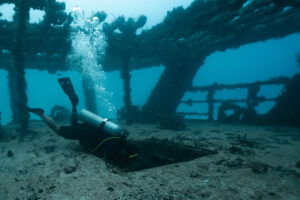What is a Scuba Diving Reel?
A scuba diving reel is an essential piece of equipment for divers, providing a reliable way to deploy and manage a line underwater. Reels are used to help divers maintain orientation, navigate, and communicate in a variety of underwater environments, from open water to complex cave systems. The versatility and functionality of reels make them a critical component of safe and effective diving practices.
History of Scuba Diving Reels
The use of reels in scuba diving has a rich history that dates back to the early days of underwater exploration. Initially, divers used simple line and spool arrangements, which provided basic functionality but lacked the sophistication of modern reels. As diving technology advanced, so did the designs of reels, incorporating new materials and engineering to meet the growing demands of the diving community.
In the mid-20th century, with the advent of technical diving, there was a significant shift in reel design. The need for more reliable and durable reels became apparent as divers began exploring deeper and more hazardous environments. Innovations such as locking mechanisms and improved line management systems were introduced, making reels more user-friendly and dependable.
By the late 20th century, reels had become an integral part of diving equipment, with manufacturers focusing on creating specialized reels for different types of diving activities. This period saw the development of reels specifically designed for cave diving, wreck diving, and other technical diving disciplines. These advancements have continued into the 21st century, with reels becoming more robust, compact, and versatile, reflecting the evolving needs of divers worldwide.
Types of Reels
There are several types of reels used in scuba diving, each serving a specific purpose and catering to different diving scenarios. Finger spools are among the simplest and most commonly used reels. They consist of a compact spool of line that can be easily deployed by hand. Finger spools are favored for their simplicity, lightweight design, and ease of use, making them ideal for both recreational and technical divers.
Safety reels are designed to be used in emergency situations, providing a reliable means of navigation back to a known point. These reels typically feature a locking mechanism to prevent the line from accidentally unwinding and are built to withstand harsh underwater conditions. Safety reels are essential for divers who venture into environments with poor visibility or complex terrain.
Jump/gap reels are specialized tools used primarily in cave and wreck diving. These reels allow divers to bridge gaps between permanent guideline systems or to navigate around obstacles. Jump/gap reels are characterized by their compact size and ease of deployment, making them indispensable for technical divers who require precise and reliable line management.
Lift bag reels are another type of reel used in scuba diving, primarily for lifting objects to the surface. These reels are designed to handle significant amounts of line and are built to support the weight of heavy objects. Lift bag reels are often used in salvage operations and underwater construction projects, where precise control over buoyancy and lifting is required.
Mechanics and Design
The mechanics and design of scuba diving reels are crucial to their functionality and reliability. A well-designed reel features a sturdy construction, often made from durable materials such as aluminum or high-grade plastic, to withstand the harsh underwater environment. The line capacity of a reel is an important consideration, with different reels offering varying lengths of line to suit specific diving needs.
Locking mechanisms are a key feature in many reels, providing a way to secure the line and prevent it from unwinding unintentionally. These mechanisms vary in complexity, from simple friction locks to more sophisticated ratchet systems. The ease of use and reliability of the locking mechanism can significantly impact a diver’s ability to manage their line effectively.
Ergonomics also play a vital role in reel design. Reels should be easy to handle, even with gloved hands, and should offer smooth and controlled deployment and retrieval of the line. The placement of handles, spools, and other components must be carefully considered to ensure optimal performance and user comfort. Additionally, the design of the reel should facilitate easy maintenance and troubleshooting, allowing divers to keep their equipment in top condition.
Practical Applications in Scuba Diving
Reels serve a variety of practical applications in scuba diving, enhancing both safety and efficiency. One of the primary uses of reels is for navigation. By deploying a line from a reel, divers can create a reference point that helps them maintain orientation and find their way back to their starting point. This is particularly important in environments with poor visibility, such as caves, wrecks, or areas with heavy silt.
In addition to navigation, reels play a critical role in safety. In the event of an emergency, such as a silt-out or entanglement, a reel can provide a lifeline back to safety. Divers can use the line to guide themselves back to a known point, reducing the risk of becoming lost or disoriented. This makes reels an essential piece of equipment for any diver, regardless of experience level.
Technical divers, who often venture into more challenging and hazardous environments, rely heavily on reels for a variety of tasks. In cave and wreck diving, reels are used to lay down guidelines that help divers navigate through complex and potentially dangerous spaces. These guidelines are crucial for maintaining a safe path in and out of these environments, ensuring that divers can safely return to the surface.
Reels are also used in more routine recreational diving activities. For instance, they can be used to deploy surface marker buoys (SMBs), which signal a diver’s position to boats and other surface observers. Reels make it easy to manage the line attached to an SMB, ensuring that it is deployed correctly and remains visible throughout the dive. This enhances both safety and communication between divers and surface support teams.
Maintenance and Care
Proper maintenance and care of scuba diving reels are essential to ensure their longevity and reliability. Regular maintenance involves cleaning the reel and its components after each dive, removing any salt, sand, or debris that may have accumulated. This helps prevent corrosion and ensures that the reel functions smoothly on subsequent dives.
Inspecting the line is another important aspect of reel maintenance. The line should be checked for signs of wear or damage, such as fraying or kinks, and replaced if necessary. Keeping the line in good condition is crucial for reliable performance and safety. Additionally, divers should periodically check the reel’s locking mechanism and other moving parts to ensure they are functioning properly.
Proper storage of reels is also vital to their upkeep. Reels should be stored in a cool, dry place, away from direct sunlight and extreme temperatures. This helps prevent degradation of the materials and ensures that the reel remains in good working condition. When storing a reel, it’s a good idea to keep the line loosely wound and free of tension, which can help prevent it from developing memory or becoming tangled.
Troubleshooting common issues is a part of routine maintenance. If a reel becomes difficult to operate or if the line does not deploy smoothly, it may be necessary to disassemble the reel and clean or lubricate the components. Many manufacturers provide detailed instructions for maintaining their reels, which can be a valuable resource for divers.
Choosing the Right Reel
Selecting the right reel for scuba diving involves considering several factors to match the diver’s specific needs and preferences. The type of diving to be undertaken is one of the primary considerations. For example, a diver planning to engage in technical cave diving will require a different type of reel than a recreational diver exploring open water reefs.
The material and construction of the reel are important factors in the selection process. Divers should look for reels made from durable materials, such as anodized aluminum or high-strength plastic, which can withstand the rigors of underwater use. The quality of the line is also crucial, with braided nylon or polyester lines being preferred for their strength and resistance to abrasion.
Another consideration is the reel’s line capacity. Divers should choose a reel that offers sufficient line length for their intended dives. For example, technical divers exploring deep caves may require reels with several hundred meters of line, while recreational divers may only need a few dozen meters.
Brand reputation and user reviews can provide valuable insights into the performance and reliability of different reels. Divers should research various brands and models, considering feedback from other divers to make an informed decision. Additionally, divers may benefit from seeking advice from experienced divers or instructors, who can offer recommendations based on their own experiences.
Price is also a factor, but it should not be the sole determining factor. Investing in a high-quality reel can enhance safety and performance, making it a worthwhile investment. Divers should balance their budget with the need for a reliable and durable reel, ensuring they choose a reel that meets their requirements without compromising on quality.
Key Takeaways
Scuba diving reels are a fundamental tool for divers, providing essential functions for navigation, safety, and technical diving applications. Understanding the history, types, mechanics, and practical uses of reels can help divers choose the right equipment and maintain it properly. Selecting a reel involves considering the specific needs of the diver, the durability of the materials, and the reel’s capacity and features. Proper maintenance ensures longevity and reliability, making reels an invaluable part of a diver’s toolkit.

















